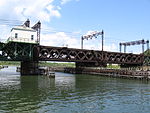South Main and Washington Streets Historic District

The South Main and Washington Streets Historic District — 68-139 Washington St. and 2-24 South Main St. is a historic district in South Norwalk, Connecticut. The 110-acre (45 ha) district encompasses 35 buildings and two other structures (including the South Norwalk Railroad Bridge). Varied architectural styles from the late 19th and early 20th centuries include Romanesque Revival, Second Empire, and Italianate architecture. Half (5.5 acres (2.2 ha)) of the area first became part of the National Register of Historic Places in 1977 (35 buildings and two structures). The district was increased in 1985 with the addition of nine buildings on 2.5 acres (1.0 ha) (11-15 through 54-60 South Main St.) and again in 1999, with another 10 buildings on 3 acres (1.2 ha), roughly along North Main Street from Washington Street to Ann Street.The original district included 26 contributing buildings and 2 other contributing structures over a 5.5-acre (2.2 ha) area. The district was first increased to add 9 contributing buildings over a 2.5-acre (1.0 ha) area. The second increase added 10 contributing buildings over a 3-acre (1.2 ha) area. The district is a densely packed area, with an 1895 railroad bridge at its "visual center". Its "primary significance" is as "an extensive and cohesive collection of late 19th century and early 20th century commercial structures."
Excerpt from the Wikipedia article South Main and Washington Streets Historic District (License: CC BY-SA 3.0, Authors, Images).South Main and Washington Streets Historic District
Seaview Avenue, Norwalk
Geographical coordinates (GPS) Address Nearby Places Show on map
Geographical coordinates (GPS)
| Latitude | Longitude |
|---|---|
| N 41.098611111111 ° | E -73.406111111111 ° |
Address
Seaview Avenue 60
06855 Norwalk
Connecticut, United States
Open on Google Maps







